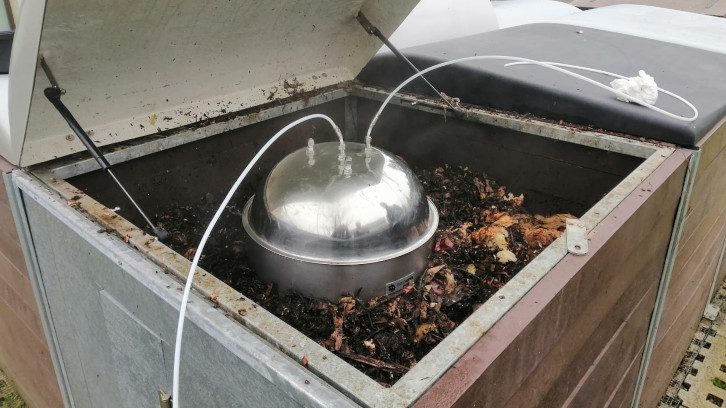Community composting, a sustainable solution for municipal biowaste management

Researchers from the Department of Chemical, Biological and Environmental Engineering of the UAB have analyzed the gas and odor emissions of community composting of municipal organic waste from selective collection. They claim that it can be an alternative and educational way of managing waste worldwide with a low environmental impact and a quality compost.
In recent decades, composting (process by which compost is obtained) has become an essential tool for the sustainable management of organic waste generated in our homes. Currently, this process is a trend in Catalonia, Spain, Europe and many parts of the world, sharing prominence with the increasingly emerging anaerobic digestion process for the production of biogas, as a source of renewable and locally available energy.
In composting, several microbial populations are responsible for degrading the organic matter contained in waste, so that finally a stable organic fertilizer is obtained, free of bad odors and pathogenic microorganisms and with numerous beneficial properties for the soil: compost.
Industrially, composting is carried out in plants of various capacities, which can treat tens of thousands of tons of waste per year. Since this implies an important logistical problem, which ranges from the selective collection of organic matter to its transport to treatment plants, in recent years a new form of composting, called decentralized, has gained attention, where the producer of the waste manages it and applies the compost locally. However, within decentralized composting, two clearly differentiated strategies can be distinguished: on the one hand, home composting, where normally a single family processes its waste in small-scale systems and, on the other, community composting, where the phases of industrial composting are tried to be reproduced (active phase, maturation and refining) and where the systems are more controlled. In community composting, successful experiences can be found in hospitals, municipal markets, hotels, universities, schools, etc. However, one of the most obvious impacts of community composting, gas and odor emissions, have been scarcely studied despite the fact that it is a critical point for its massive implementation.
For this reason, in this work we presented a first study on the systematic determination of these emissions in real community composters, all of them processing municipal organic waste from selective collection, specifically in Galicia, Navarra and Catalonia. We determined emissions of ammonia, greenhouse gases (methane and nitrous oxide), and volatile organic compounds in situ at different times during the process.
As main conclusions from all the data obtained, we can state that, first of all, in the case of greenhouse gases and odors, the values detected are low, when compared to the emissions found in industrial plants. Also, in the case of ammonia, the same patterns are followed as those observed in industrial composting, with emissions being strongly dependent on the age of the material and its temperature. Finally, in the case of volatile organic compounds, no significant quantities of toxic compounds were detected, with terpenes being the majority product.
Therefore, as a general conclusion, we can highlight the fact that community composting can be a sufficiently attractive management tool in certain contexts, with a low environmental impact and producing quality compost. It is also evident that this type of composting is both a tool for environmental education and citizen science. In any case, the work represents an important advance in the field of community composting, which until now had been approached in an unscientific manner.
Antoni Sánchez
Department of Chemical, Biological and Environmental Engineering
Universitat Autònoma de Barcelona
References
Daniel González, Raquel Barrena, Javier Moral-Vico, Ignacio Irigoyen, Antoni Sánchez. Addressing the gaseous and odour emissions gap in decentralised biowaste community composting. Waste Management, 178, 2024, 231-238 https://doi.org/10.1016/j.wasman.2024.02.042


